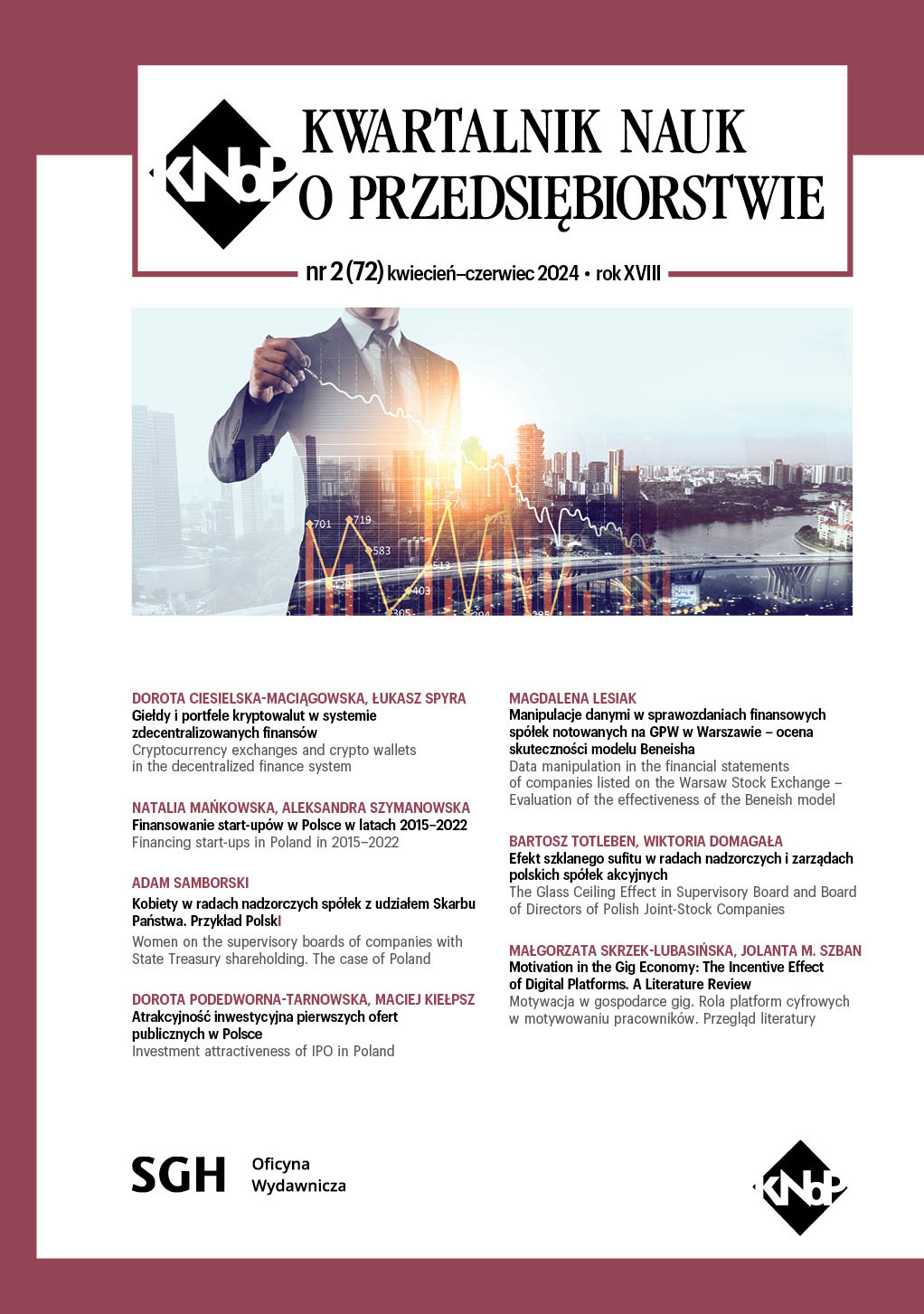Giełdy i portfele kryptowalut w systemie zdecentralizowanych finansów
Main Article Content
Abstrakt
Kluczowym wyzwaniem dla inwestorów oraz użytkowników jest zrozumienie podstawowych mechanizmów umożliwiających efektywne zarządzanie i alokację cyfrowych aktywów. Rozwój kryptowalut zapoczątkował powstanie systemu giełd, które działają jako pośrednicy w obrocie cyfrowymi aktywami oraz portfeli kryptowalutowych. Scentralizowane giełdy kryptowalut funkcjonują jako pośrednik między kupującym a sprzedającym i pozyskują środki pieniężne dzięki prowizjom i opłatom transakcyjnym. Z kolei zdecentralizowana giełda pozwala na przeprowadzanie transakcji peer-to-peer bezpośrednio z portfela cyfrowego, bez udziału pośrednika. Portfele kryptowalut umożliwiają przechowywanie, wymianę oraz aktywne uczestnictwo i wspieranie sieci blockchain, czyli staking tokenów. W konsekwencji celem niniejszego artykułu jest przedstawienie specyfiki systemu giełd oraz portfeli kryptowalutowych. Metoda badawcza wykorzystana w niniejszym artykule obejmuje analizę literatury naukowej oraz badań dotyczących kryptowalut.
Downloads
Article Details

Utwór dostępny jest na licencji Creative Commons Uznanie autorstwa 4.0 Międzynarodowe.
Autor (Autorzy) artykułu oświadcza, że przesłane opracowanie nie narusza praw autorskich osób trzecich. Wyraża zgodę na poddanie artykułu procedurze recenzji oraz dokonanie zmian redakcyjnych. Przenosi nieodpłatnie na Oficynę Wydawniczą SGH autorskie prawa majątkowe do utworu na polach eksploatacji wymienionych w art. 50 Ustawy z dnia 4 lutego 1994 r. o prawie autorskim i prawach pokrewnych – pod warunkiem, że praca została zaakceptowana do publikacji i opublikowana.
Oficyna Wydawnicza SGH posiada autorskie prawa majątkowe do wszystkich treści czasopisma. Zamieszczenie tekstu artykuły w repozytorium, na stronie domowej autora lub na innej stronie jest dozwolone o ile nie wiąże się z pozyskiwaniem korzyści majątkowych, a tekst wyposażony będzie w informacje źródłowe (w tym również tytuł, rok, numer i adres internetowy czasopisma).
Osoby zainteresowane komercyjnym wykorzystaniem zawartości czasopisma proszone są o kontakt z Redakcją.
Bibliografia
Barbon A., Ranaldo A. [2023], On the Quality of Cryptocurrency Markets: Centralized Versus Decentralized Exchanges, Cornell University, https://doi.org/10.48550/arXiv.2112.07386.
Bentov I., Ji Y., Zhang F., Breidenbach L., Daian P., Juels A. [2019], Tesseract: Real-Time Cryptocurrency Exchange Using Trusted Hardware, CCS ‘19: Proceedings of the 2019 ACM SIGSAC Conference on Computer and Communications Security, November, s. 1521–1538, https://dl.acm.org/doi/abs/10.1145/3319535.3363221.
Canessane R. A., Srinivasan N., Abinash B., Ashwini S., Kumar B. M. [2019], Decentralised Applications Using Ethereum Blockchain, International Conference on Science Technology Engineering and Mathematics (ICONSTEM), Chennai, India, s. 75–79, https://doi.org/10.1109/ICONSTEM.2019.8918887.
Chalkias K., Chatzigiannis P., Yan J. [2022], Broken Proofs of Solvency in Blockchain Custodial Wallets and Exchanges, Cryptology ePrint Archive, https://eprint.iacr.org/2022/043.
Chen You-Ping, Ju-Chun Ko [2019], CryptoAR Wallet: A Blockchain Cryptocurrency Wallet Application That Uses Augmented Reality for On-Chain User Data Display, Proceedings of the 21st International Conference on Human-Computer Interaction with Mobile Devices and Services, MobileHCI’19, New York, s. 1–5, https://doi.org/10.1145/3338286.3344386.
Essén A., Ekholm A. [2020], Centralization vs. decentralization on the blockchain in a health information exchange context, Digital Transformation and Public Services, s. 58–82.
Fareed T. [2023], A Systemic Review of Payment Technologies with a Special Focus on Digital Wallets, w: Turi A. N. (red.), Financial Technologies and DeFi. Financial Innovation and Technology, Springer, Cham, s. 89–97, https://doi.org/10.1007/978-3-031-17998-3_6.
Gkaniatsou A., Arapinis M., Kiayias A. [2017], Low-Level Attacks in Bitcoin Wallets, w: Phong Q. Nguyen, Jianying Zhou (red.), Information Security, „Lecture Notes in Computer Science”, vol. 10599, Springer International Publishing, Cham, s. 233–253, https://doi.org/10.1007/978-3-319-69659-1_13.
Hyeji J., Sung H. Han, Ju Hwan Kim, Kimin Kwon [2021], Usability Evaluation for Cryptocurrency Exchange, w: Gutierrez A. M. J., Goonetilleke R. S., Robielos R. A. C. (red.), Convergence of Ergonomics and Design, „Advances in Intelligent Systems and Computing”, vol. 1298, Springer International Publishing, Cham, s. 192–196, https://doi.org/10.1007/978-3-030-63335-6_20.
Jiahua Xu, Paruch K., Cousaert S., Feng Y. [2023], SoK: Decentralized Exchanges (DEX) with Automated Market Maker (AMM) Protocols, „ACM Computing Surveys”, vol. 55 (11), s. 1–50, https://doi.org/10.1145/3570639.
Kancelaria Prezesa Rady Ministrów [2024], Projekt ustawy o kryptoaktywach, Kancelaria Prezesa Rady Ministrów, Portal gov.pl, https://www.gov.pl/web/premier/projekt-ustawy-o-kryptoaktywach (data dostępu: 1.06.2024).
Khan A. G., Amjad Hussain Z., Muzammil H., Riaz U. [2019], Security Of Cryptocurrency Using Hardware Wallet And QR Code, International Conference on Innovative Computing (ICIC), Lahore, Pakistan, https://doi.org/10.1109/ICIC48496.2019.8966739.
Kumar M., Nikhil N., Singh R. [2020], Decentralising Finance Using Decentralised Blockchain Oracles, International Conference for Emerging Technology (INCET), Belgaum, India, s. 1–4, https://doi.org/10.1109/INCET49848.2020.9154123.
McMenamin C., Daza V., Fitzi M., O’Donoghu P. [2022], FairTraDEX: A Decentralised Exchange Preventing Value Extraction, ACM CCS Workshop on Decentralized Finance and Security, Association for Computing Machinery, New York, s. 39–46, https://doi.org/10.1145/3560832.3563439.
Platt M., Pierangeli F., Livan G., Righi S. [2020], Facilitating the Decentralised Exchange of Cryptocurrencies in an Order-Driven Market, Conference on Blockchain Research & Applications for Innovative Networks and Services (BRAINS), Paris, s 30–34, https://doi.org/10.1109/BRAINS49436.2020.9223286.
Qin K., Zhou L., Afonin Y., Lazzaretti L., Gervais A. [2021], CeFi vs. DeFi – Comparing Centralized to Decentralized Finance, Cornell University, https://doi.org/10.48550/arXiv.2106.08157.
Samer B., Qais H., Khalil Y. [2022], Comparison of Hardware and Digital Crypto Wallets, „Journal of Southwest Jiaotong University”, vol. 57 (6), http://jsju.org/index.php/journal/article/view/1414 (data dostępu: 30.05.2024).
Sans T., Ziming L., Oh K. [2023], A Decentralized Mnemonic Backup System for Non-Custodial Cryptocurrency Wallets, w: Jourdan G.‑V., Mounier L., Adams C., Sèdes F., Garcia-Alfaro J., Foundations and Practice of Security, Lecture Notes in Computer Science, Springer Nature Switzerland, Cham, s. 355–370, https://doi.org/10.1007/978-3-031-30122-3_22.
Simplilearn.com [2023], What Is Blockchain Wallet and How Does It Work? https://www.simplilearn.com/tutorials/blockchain-tutorial/blockchain-wallet (data dostępu: 30.05.2024).
Sobiecki G. [2014], Walut światy równolegle, „Kwartalnik Nauk o Przedsiębiorstwie”, vol. 33 (4).
Taylor S., Ho-Yong Kim S., Akram Zainol Ariffin K., Siti Norul Huda Sheikh A. [2022], A Comprehensive Forensic Preservation Methodology for Crypto Wallets, „Forensic Science International: Digital Investigation”, vol. 42–43, https://doi.org/10.1016/j.fsidi.2022.301477.
Tyler T., Piscitelli M., Shavrov I., Baggili I. [2020], Memory Foreshadow: Memory FOREnSics of HArDware CryptOcurrency Wallets – A Tool and Visualization Framework, „Forensic Science International: Digital Investigation”, vol. 33, https://doi.org/10.1016/j.fsidi.2020.301002.
UKNF [2021], Ostrzeżenie Urzędu KNF o ryzykach związanych z nabywaniem oraz z obrotem kryptoaktywami (w tym walutami wirtualnymi oraz kryptowalutami), Urząd Komisji Nadzoru Finansowego, Warszawa, 12 stycznia, https://www.knf.gov.pl/knf/pl/komponenty/img/Ostrzezenie_UKNF_o_ryzykach_zwiazanych_z_nabywaniem_oraz_z_obrotem_kryptoaktywami_72241.pdf (data dostępu: 30.05.2024).
Wang Q., Rujia Li W., Qi Wang, Chen S. [2021], Non-Fungible Token (NFT): Overview, Evaluation, Opportunities and Challenges, Cornell University, http://arxiv.org/abs/2105.07447.
Wang Y., Lu W., Liu M.‑B., Ren R., Härdle W. K. [2024], Cross-Exchange Crypto Risk: A High-Frequency Dynamic Network Perspective, „International Review of Financial Analysis”, vol. 94, https://doi.org/10.1016/j.irfa.2024.103246.

